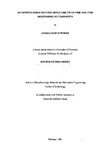AN INVESTIGATION INTO THE APPLICABILITY OF NMR FOR CURE MONITORING OF COMPOSITES
| dc.contributor.author | NEWBURY, ANGELA LOIS | |
| dc.contributor.other | School of Engineering, Computing and Mathematics | en_US |
| dc.date.accessioned | 2013-10-03T12:22:36Z | |
| dc.date.available | 2013-10-03T12:22:36Z | |
| dc.date.issued | 1994 | |
| dc.identifier | NOT AVAILABLE | en_US |
| dc.identifier.uri | http://hdl.handle.net/10026.1/2005 | |
| dc.description.abstract |
Fibre-reinforced polymer-matrix composite materials have highly attractive physical properties which justify the present rapid increase in applications within industry. However, composite materials suffer, like every structural material, from a failure to achieve their design properties. Therefore this research project has investigated the processing of resin used in composite materials. Initially the research programme has been concerned with the cure of epoxy resins (specifically Araldite MY750 epoxy resin system), the behaviour of the resin as it cures and how the extent of cure can affect the mechanical properties of components. Therefore, investigations have been carried out into how resin cure can be monitored by the NMR spectra and the relaxation time properties. There were four methods of analysing the data investigated, overall transverse relaxation time (T2) and free induction decay data (FID) data using the Oxford QP NMR analyser, transverse relaxation time data and spectral changes for the individual chemical environments using the Jeol EX270 NMR spectrometer, curemeter investigations using the vibrating needle curemeter (VNC) and finally Barcol hardness investigations during the later part of the cure cycle. Both the Jeol NMR spectrometer and the Oxford QP NMR analyser are designed for use primarily with liquid-state experimentation, however for the spectral, relaxation time, and FID investigations results were obtained far longer in the cure than expected. Also for the T2 investigations a transition period was noticed in the data obtained that corresponded to the gel of the resin as determined by known viscosity data for that resin mix at that cure temperature. The use of NMR as a curemeter technique was verified by repeating the analysis of the resin cure at 40, 60, 80 and 100°C. This data was then compared to known viscosity data and cure profiles obtained by the VNC curemeter and Barcol hardness readings on similar sized samples. | en_US |
| dc.description.sponsorship | Oxford Instruments, Industrial Analysis Group | en_US |
| dc.language.iso | en | en_US |
| dc.publisher | University of Plymouth | en_US |
| dc.title | AN INVESTIGATION INTO THE APPLICABILITY OF NMR FOR CURE MONITORING OF COMPOSITES | en_US |
| dc.type | Thesis | |
| plymouth.version | Full version | en_US |
| dc.identifier.doi | http://dx.doi.org/10.24382/4522 | |
| dc.identifier.doi | http://dx.doi.org/10.24382/4522 |
Files in this item
This item appears in the following Collection(s)
-
01 Research Theses Main Collection
Research Theses Main


